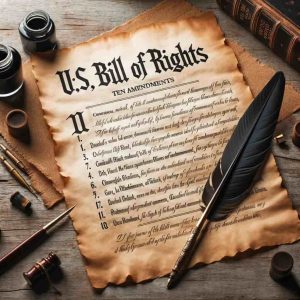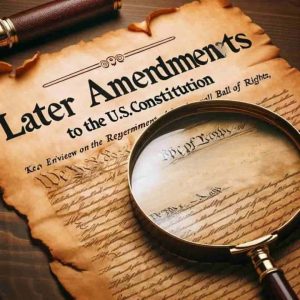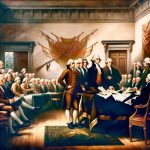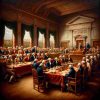The US Constitution of 1787 is the foundation of the American vote-based system, a report that has endured everyday hardship and keeps directing the country’s administration, privileges, and values. This 3000-word article will investigate the Constitution exhaustively, revealing insight into its authentic foundation, drafting process, key Initial architects, design, crucial standards and beliefs, confirmation cycle, the meaning of the Bill of Freedoms, its effect and impact, the advancement of the Constitution, difficulties and reactions it has confronted its contemporary significance, and its getting through heritage.
Historical Context
“The journey of the U.S. Constitution began as a result of the American Revolution when it became clear that the existing system under the Articles of Confederation was inadequate for providing a stable and unified government. This realization led to the convening of the Constitutional Convention in Philadelphia in 1787.”
Drafting The Constitution
The Show was a get-together of representatives from each state who met up to draft another constitution to give a more viable and brought-together administration arrangement. Key figures in this cycle included James Madison, frequently called the “Father of the Constitution,” who assumed a crucial part in forming the report. The drafting system was complicated, with extreme discussions and compromises.
Key Principal architects
The U.S. Constitution’s creators were a recognized gathering of people who established the groundwork for a vote-based country. Figures like George Washington, who managed the Show; Benjamin Franklin, the revered senior legislator; and Alexander Hamilton, an intense promoter for a solid central government, all contributed their bits of knowledge and trickery to make a fair system that would direct the country into the indefinite future.
Creation of the Constitution
The Constitution is coordinated into three fundamental parts: the Preface, the Articles, and the Revisions. The Preface, a smooth presentation, establishes the vibe for the Constitution and lays out its motivations. The Articles are the core of the archive, outlining the powers and obligations of each part of government – the authoritative, chief, and legal. The Revisions give a component to change, permitting the Constitution to adjust to the developing necessities of society.
Standards and Goals: The Constitution isn’t only an authoritative record; it encapsulates center rules that have molded the American government arrangement. The partition of abilities is one of these essential standards, separating the public authority into three branches, guaranteeing governing rules that keep any one component from becoming excessively strong.
Federalism: Federalism is one more foundation of the Constitution, splitting powers between the bureaucratic and state legislatures, advancing local independence while keeping a brought-together country. This harmony among unified and decentralized authority is at the core of American federalism.
Individual Privileges: The assurance of individual privileges is revered in the Bill of Freedoms, the initial ten revisions to the Constitution. These corrections ensure fundamental opportunities and security, including the right to speak freely, religion, and the right to a fair preliminary. The Bill of Freedoms guarantees that the public authority regards the freedoms of its residents.
Approval Cycle: The way to approval of the Constitution was laden with discussions and obstruction. Federalists, who upheld the new Constitution, conflicted with Enemies of Federalists, who were worried about the potential for a strong national government. The endorsement interaction included serious conversations and compromises, ultimately prompting the reception of the Constitution. It was a vast, forward-moving step in laying out a more durable and successful administration arrangement.
 US Constitution and the Bill of Rights
US Constitution and the Bill of Rights
The initial ten revisions to the Constitution, known as the Bill of Rights, demonstrate the significance of safeguarding individual freedoms. These corrections defend fundamental opportunities, for example, the option to free discourse, the opportunity of religion, and the right to a fair and rapid preliminary. The Bill of Freedoms remains an essential part of the American majority rules system, guaranteeing that the public authority regards and maintains the privileges of its residents.
Effects and Impacts
The impact of the U.S. Constitution stretches out a long way past American lines. The standards of freedom, a majority rules system, and equity exemplified in the Constitution have filled in as a model for some countries across the globe. It has motivated majority rule developments and protected strategies in various nations, supporting its status as a signal of popularity-based goals.
 Development of the Constitution
Development of the Constitution
The Constitution has remained static since its commencement. It has developed through revisions and milestone High Court choices throughout the long term. The 27 amendments to the Constitution reflect changes in American culture and values, going from issues like democratic freedoms to official service time boundaries. The Constitution’s flexibility is a demonstration of its perseverance through pertinence.
Difficulties and Reactions
While the U.S. Constitution is worshipped, it has confronted its portion of reactions and difficulties over now is the ideal time. Issues like subjection, which could have been satisfactorily tended to in the first text, orientation disparity, and the constituent school framework have created discussions and debates. These difficulties have incited continuous conversations about the requirement for additional alterations and updates to guarantee that the Constitution keeps mirroring contemporary America’s qualities and desires.
Contemporary Importance
The U.S. Constitution isn’t a remnant of the past; it remains a living record directing the American majority rules system. Current discussions on security, weapon control, and chief powers are established in the understanding of the Constitution. As society changes and new difficulties arise, the Constitution fills in as a standard, offering direction and a system for settling debates and molding public strategies.
The Constitution’s Heritage
The U.S. Constitution of 1787 has left a significant and persevering through inheritance, molding the American personality and filling in as an image of a majority rules government and opportunity. Its standards and goals have endured over the long haul, giving a steady groundwork to the American administration.
Conclusion
In a world set apart by steady change and vulnerability, the U.S. Constitution (1787) remains a guide of solidness and a demonstration of the getting through force of majority rule beliefs. Its heritage keeps on impacting the U.S. and countries all over the planet, making it the main report throughout the entire existence of a majority government.











